![]()
The Mars Perseverance Rover, which already has sent back some incredible images from the Red Planet, is equipped with 23 cameras designed for a host of tasks. Its main camera array is particularly impressive, able to see details as small as a tip of a pencil close by, and the size of an almond from a football field away in 3D.
The cameras on Perseverance have three main improvements over those that flew on Curiosity: they can take color images, they have a wider field of view, and they have more resolution. In total, these three aspects greatly improve the quality of images taken by even the rover’s engineering cameras.
The diagram below shows an approximation of where the many different cameras are on the rover. There are nine engineering cameras, seven science cameras, and seven entry, descent, and landing cameras. Included in this batch is the Mastcam-Z, possibly the rover’s most impressive camera.
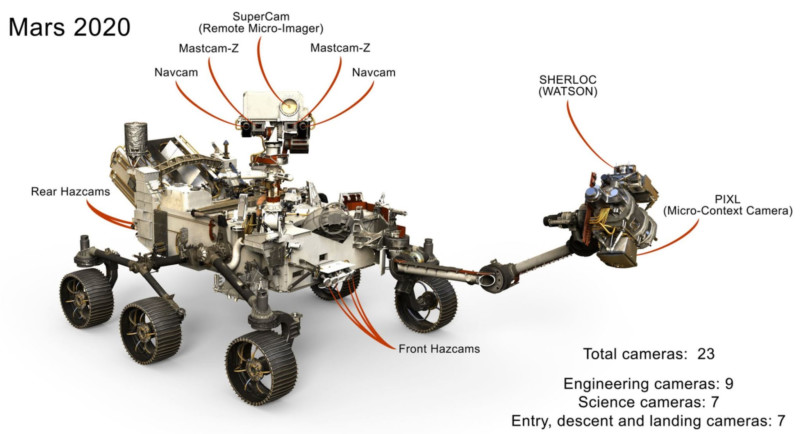
The Mastcam-Z is what the mast-mounted camera system is called and it is actually two cameras that work together to produce 3D stereoscopic images. It can zoom, focus, and take pictures and video at high speed to allow for detailed examinations of distant objects. It is the highest-resolution color imaging system yet sent to Mars and is the first camera system sent to the Red Planet with built-in zoom capability.
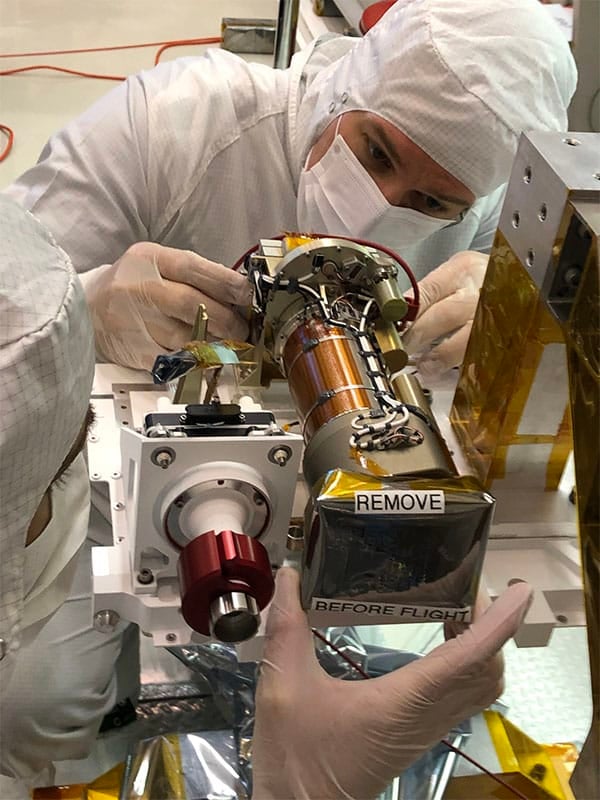
“Mastcam-Z is a multi-color, stereo imaging system on NASA’s Perseverance rover,” the camera’s description reads.
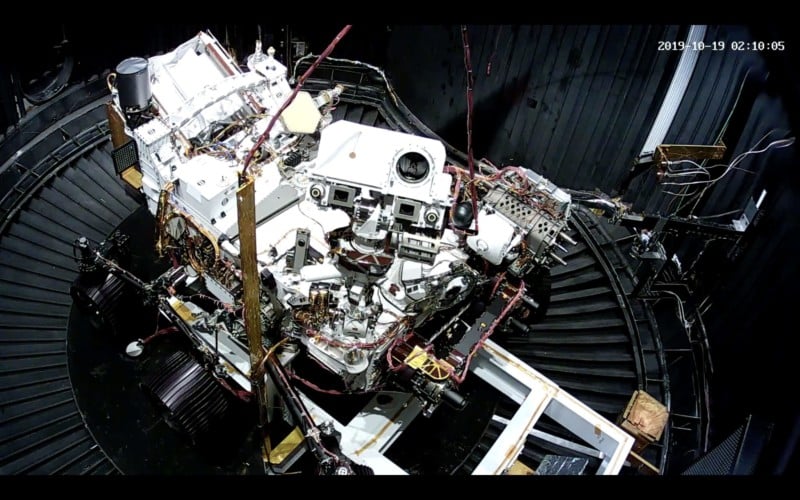
“Mastcam-Z uses a pair of focusable, zoomable cameras on the rover’s mast to image in ‘human-like’ red/green/blue colors and in ultraviolet and infrared colors just beyond the range of human color perception. At maximum zoom, the cameras see features as small as the tip of a pencil close by, and the size of an almond from a football field away.”
According to the technical specifications, the Mastcam-Z is capable of resolving between about 150 microns per pixel (0.15 millimeter or 0.0059 inches) to 7.4 millimeters (0.3 inches) per pixel depending on the distance.
The zooming mechanism itself is an engineering marvel, as shown below:
As explained by Redditor redmercuryvendor, the optical design of the Mastcam-Z shares similarities to the zoom lenses on consumer cameras, but the zoom mechanism itself is different.
“Zoom lenses for regular cameras run inside the helicoids, which are visible here too (the curved tracks that guide the lens mounts), but they run on just the helicoids,” redmercuryvendor explains. “A little grease and some lubricious bushing materials and they slide in and out just fine. But as anyone who’s played with an old lens has probably found, even a smoothly operating lens will degrade and become tough to move over time as the grease breaks down and becomes sticky, and eventually a lens can ‘lock up’ and require disassembly for cleaning and regreasing.”
![]()
Clearly, this would be an issue when the lens can’t be repaired because it’s on a different planet.
“You can’t do that on Mars, so instead the lens elements run on precision linear rails with recirculating ball slides, and the focusing helicoids just perform the job of moving the lenses, not supporting them too. The ball slides can be manufactured and operated without any grease, so there is no volatile material to degrade in the thin atmosphere.”
The two identical cameras (except for small differences in the color filters) that make up the Mastcam-Z camera system are mounted about 2 meters (6.5 feet) above the surface, on the rover’s Remote Sensing Mast separated by 9.5 inches to provide stereo vision.
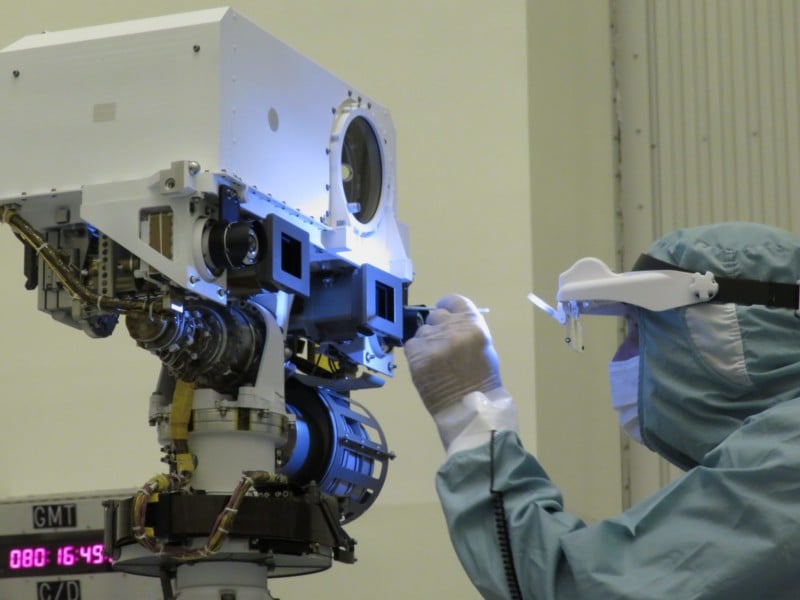
“Each camera consists of four major subsystems: A digital CCD sensor and electronics box, an 8-position filter wheel, a multi-lens zoom assembly, and a single-lens focusing assembly,” the Mastcam-Z’s description reads. “A short light shade helps reduce scattered light in the optics. A separate Digital Electronics Assembly is mounted inside the rover, and two calibration targets are mounted on the rover deck.”
Below is a cross-sectional CAD view and ray-trace diagram of the Mastcam-Z optics. You can see two small motors that drive the zoom and focus mechanisms.
![]()
Below is a CAD animation and cross-sectional view of the focus mechanism in action:
Mastcam-Z can zoom from wide-angle to telephoto and take photos in up to 11 unique colors. It shoots in a 1600×1200 pixel range and can zoom from 26-110mm as well as rotate a full 360-degrees. The camera has a maximum aperture of f/7 at the wide end and f/10 at the telephoto end.
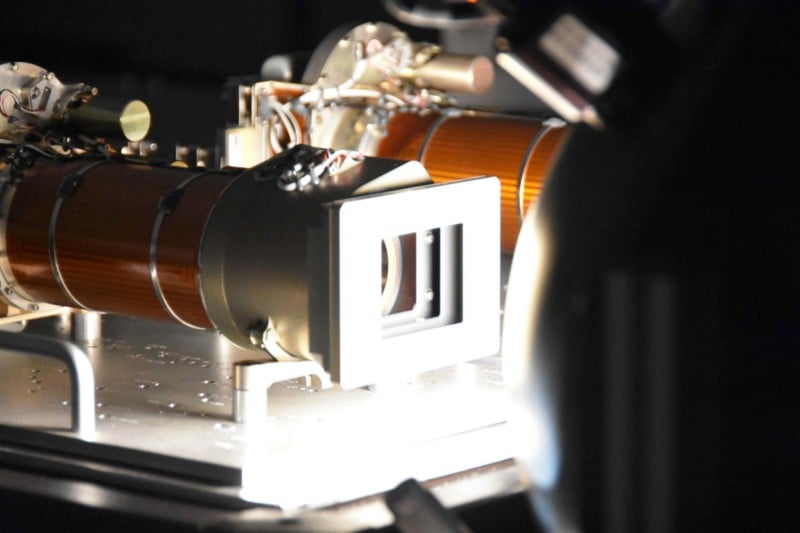
For a sense of scale, NASA uploaded an image of the two sides of the Mastcam-Z camera next to a pocket knife:
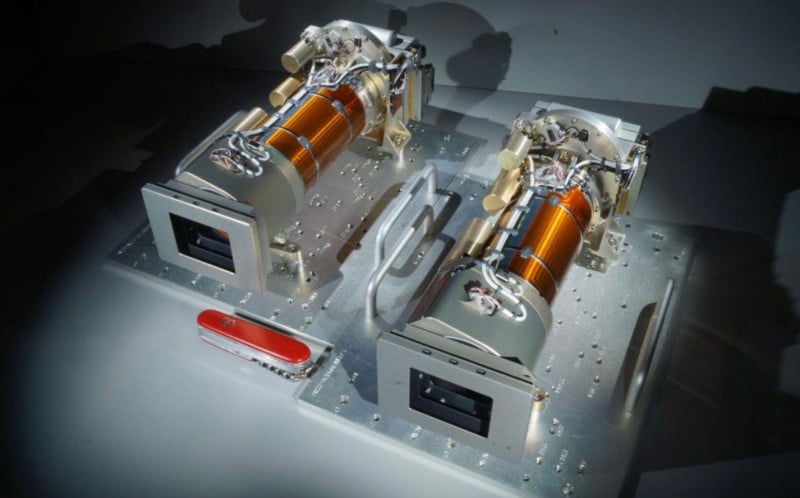
The Mastcam-Z is in place for three primary reasons. First, Perseverance will use it to characterize the overall landscape geomorphology, processes, and the nature of the geologic record (mineralogy, texture, structure, and stratigraphy) at the rover field site. Second, it will assess current atmospheric and astronomical conditions and interactions between the surface and the atmosphere. Finally, it will provide operational support and scientific context for rover navigation and imaging support for the other instruments and tools.

You can peruse the results of the imaging technology throughout the Mars mission as NASA continues to upload images from Perseverance here.
Image credits: Header image by MSSS/ASU
Author: Jaron Schneider
Source: Petapixel



